Robinson College Library: Our History
Robinson College is proud of its history as the first purpose-built co-educational Cambridge college for undergraduate and postgraduate students. Designed by Andy Macmillan and Isi Metzstein, architects who gained recognition for modern Scottish churches, the Library is one of the architectural highlights of the College. Andy and Isi firmly believed that a good building should never reveal itself at any given moment in entirety. They advocated partial revelation, with aspects simultaneously revealed and obscured as the ideal. The Library adheres to this principle with wonderful views of both the interior and the exterior as you walk around. This concept of partial revelation is also expressed with the Piper/Reyntiens stained glass windows in the Chapel.

By 1977 planning had commenced with the formation of the Library Committee. They had a brief to establish a library for 350 to 400 undergraduates. Commander George Coupe worked tirelessly on this brief for the first two years. He consulted and visited the libraries at Trinity, Kings and Churchill in order to get a clear understanding of what was required and Godfrey Thompson, then President of the Library Association, gave invaluable advice.
The foundation of our collection came from some 18,000 books acquired from Hockerill College in Bishop Stortford, which was just about to close. This had been a teacher training college, established in 1852 by the Church of England for the training of women teachers; it subsequently re-opened as a co-educational boarding school in 1980. With some 5000 new books purchased by 1979 the University Library kindly offered us space to store our growing collection on the 9th floor of their tower.
In November 1978 Dr Mikuláš Teich became the first Fellow Librarian and had to ready the library in time for the first intake of 20 undergraduates in Michaelmas 1979. The library found a home in a bay-windowed room in Thorneycreek House: a building in the college gardens dating from 1895. The books were placed on beautiful oak shelving, bought from Lincoln Cathedral. The library soon doubled in size and spread into offices vacated by admin staff before being moved across the site for the opening of the new Library at the start of Easter Term 1981.
There have been many generous donations over the years which have helped to shape our collection. Of particular note was the Munby Collection on Transport Economics and the A.G. Dickens Collection, both of which are no longer held. The Henry Button Collection of Business Histories is a fascinating and unique collection which came to us, as a new College, in 1981. We have a good selection of Piper and Reyntiens related material and hold Arts Council exhibition catalogues from 1948-1972. In 2019 we received an interesting bequest from Miss V J Bowles on local history, which now forms the basis of our Bowles Collection.
Fellow Librarians: Dr Mikuláš Teich, Dr Martin Brett, Professor German Berrios, Dr David McKie, Wing Commander Peter Milloy, Professor Rosalind Love, Professor Peter Kornicki. College Librarians: Alison Houghton, Lesley Read, Judith Brown
The Light In the Library, image copyright Judith A. Brown
Introducing Book Bridges...
A year of sharing books and stories from Robinson College Library
For a little over two years I have had the privilege of being librarian of this wonderfully rich library collection and on many occasions I have been surprised and delighted by the book treasures that we hold. As a new college we were indebted to Hockerill College in Bishop Stortford for some18,000 titles purchased from them in 1978, at the time of their closure. This became our foundation collection. Fast forward forty years and our collection now totals approximately 58,000 titles with the oldest dating from the 18th Century.
In my professional life as a librarian I have worked in eight different libraries and each one of these has had their own distinct and individual collection. It is fascinating to dig beneath the surface to try to understand how a library has been formed. There are usually important personalities who have shaped the collection, through their personal connections and associated donations. Then there is the steering influence of the interests and subject expertise of the community that the library serves.
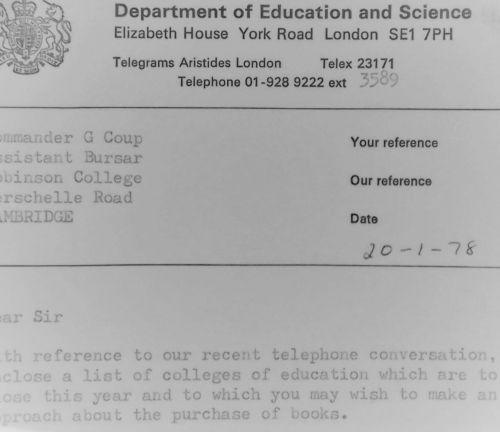
Commander George Coupe’s decision to contact the Department of Education and Science, requesting details of colleges of education about to close, was a masterstroke. The titles we acquired from the teacher training college for women have played an important part in shaping our collection particularly in Fine Arts, History and English Literature. We have the correspondence from this time detailing the negotiations that took place to secure these books involving Dr Mary Stewart and Dr Helena Mennie Shire. We benefitted from the wish of the Trustees and Governors of Hockerill College that their books "go to a sympathetic and appropriate institution." In addition we have a fantastic cluster of titles on John Piper, whose friendship with the college after his stained glass commission continued until his death. We also have the eclectic Button Collection of Business Histories and a useful collection on the local history of Cambridgeshire bequeathed by Valerie Bowles, daughter of a former Cambridge mayor.
Previous marks of ownership are visible in many of our books. You will frequently see the Hockerill College library stamp and date label, and also bookplates from other libraries and individuals. I like this connection between book and person, past and present. One of the definitions of bridge in the Cambridge Dictionary is “something that makes it easier to make a change from one situation to another.” I believe that each and every book we read can act as a bridge, although we might not always appreciate how it is changing us.
Over the coming year we will be sharing 30 Book Bridges. Please follow along on the website and on Twitter.
Clause 171 and the Inspector of Nuisances - Book Bridge No.1
This feels like a good place to start our Book Bridges journey, with a small, brown, cloth-covered book of 136 pages from 1932. Books and Readers in Ancient Greece and Rome, Oxford University Press, collates three lectures from Frederic G. Kenyon, the Director and Principal Librarian of the British Museum from 1909 until 1930.
Kenyon states that his words are supplementary to the standard works on ancient book-production, covering the period from the date of Homer until the use of vellum as the principal material for books from the fourth century onwards. We don’t hold a collection of papyri here at Robinson, so we have to enjoy this book form one step removed. My favourite illustration is of a capsa or book-box (page 59), holding papyrus rolls.
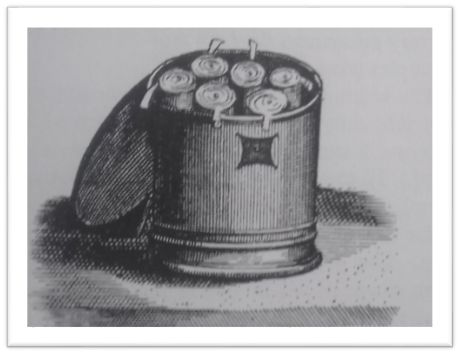
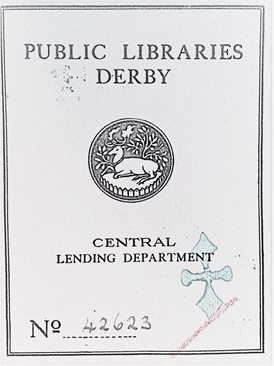
It seems that before this book made its way to us it was in circulation at the Public Libraries of Derby. What an interesting book plate they had!
It is a common sight to see previous marks of ownership in our books; as a new college we needed to acquire books on a budget. This book is numbered 42623 and in 1901 there was the need to include the following clause from the Derby Corporation Act. Clause 171 is printed on a slip of paper in bright red ink and stuck onto the first page of the book. It reads –
Special Notice
-------
The attention of Borrowers is directed to the following Extract from Clause 171, Derby Corporation Act 1901.
“No person shall return to any Lending Library any book which has been to his knowledge exposed to infection from any infectious disease, but shall at once give notice that it has been exposed to infection to the Medical Officer of Health or to the Inspector of Nuisances, who shall cause the same to be disinfected and then returned to the Librarian. If any person offends against this enactment he shall be liable to a penalty not exceeding forty shillings.”
In 2020 the library world once again finds itself debating the transmission risk of infectious disease from books… but we no longer have an Inspector of Nuisances overseeing such matters!
As of an alligator, coarser than a lizard, finer than a crocodile…Book Bridge No. 2
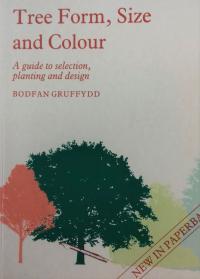
Our second Book Bridge is Tree Form, Size and Colour: a guide to selection, planting and design by John St. Bodfan Gruffydd which was published in 1987. The author, 1910-2004, was the landscape architect at Robinson and passionate about the importance of trees. He championed the role of his profession at a time when the number of qualified practitioners in the UK would have been less than 50. He was acutely aware of the environmental consequences that our use of land was having and advocated for the establishment of ‘biological corridors’ to mitigate the detrimental effects.
The idea of ‘biological corridors’ had been introduced to him whilst working with Frederick Gibberd on Harlow New Town. The corridors consisted of thick wedges of land embedded within small clusters of towns which were grouped around the city centre. The facility that this allowed for balancing town and country living was enthusiastically explained by Bodfan:
"This was absolutely marvellous because, for example, I could go out from my house in Halling Hill and I could walk the length of one of these wedges, through existing copses joined by belts of new planting, out into the countryside, right out into Epping Forest if I wanted to, with my corgis."
Our copy of this book has a warm inscription by the author to our Warden, Jack Lewis.
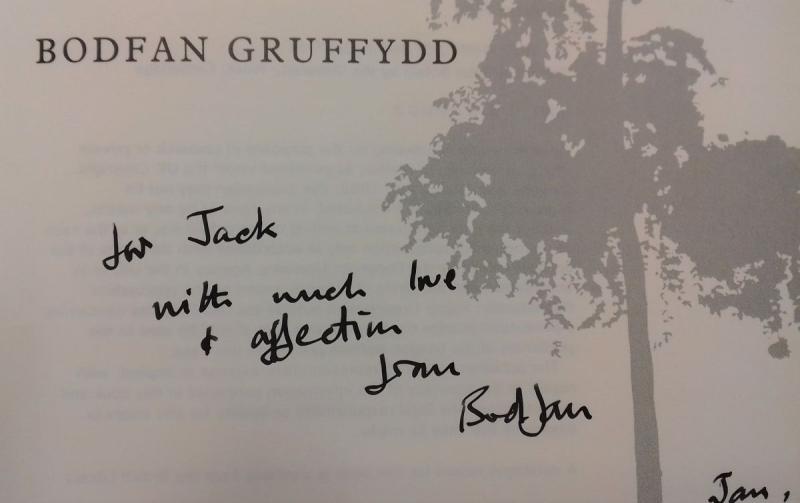
Bodfan said the idea for the book had come about due to the lack of an existing volume detailing all that was to be considered when planting trees. It is packed with tree facts including foliage colour and appearance, shade giving properties and details of USM or ultimate spacing in metres to allow optimum growth.
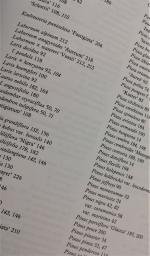
There is a wonderful glossary at the end of the book charting all the different kinds of surface foliage patterns complete with author’s notes. Describing scaly foliage patterns he says “as of an alligator, coarser than a lizard, finer than a crocodile.”
Some twenty years earlier he had written Landscape Architecture for New Hospitals, a report published in 1967 by the King Edward’s Hospital Fund, which was ahead of its time in recognising the healing benefits of gardens. In a paper delivered to the Royal Society of Arts, in 1973 the Year of the Tree, he praised the foresight and generosity of those who plant trees not for their own benefit but for future generations.
“How lucky we are to have had such ancestors who were prepared to spend money planting trees.”
Bodfan was chosen to plan our gardens on the recommendation of John Piper to David Robinson. He managed to seamlessly combine ten original gardens, retaining plantings from the 1890’s and added an elevated walkway over Bin Brook to link building to garden. In addition to the gift of magnificent landscaped gardens he generously bequeathed the college his John Piper art collection.
Symphony No. 39 in E flat - Book Bridge No. 3

This week we have not one title but a whole series from the 1950s.
Our library has many of these “pocket” titles and it was their beautifully designed covers which captivated me, encouraging a closer look. The Penguin Scores were published between 1949 and 1956 and featured 30 classic symphonies, overtures etc. They were edited by Gordon Jacob, a prolific 20th century composer who gave context to each work by writing a concise introductory piece at the start of each book. There was also a biographical summary of the composer, written by many different authorities - Joan Chissell on Schumann, Ralph Hill on Mendelssohn and F. Bonavia on Mozart.
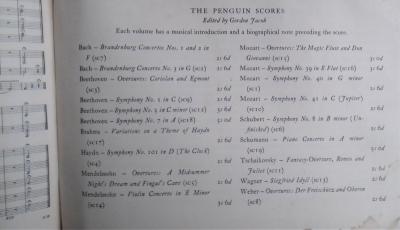
The design was strongly influenced by the work of Jan Tschichold, an eminent typographer and book designer, who transformed design at Penguin between the years of 1946 to 1949. He worked on some 500 paperbacks developing the publishers’ brand, laying out his design principles in the Penguin Composition Rules. The series format is distinctive with Garamond typeface, in a landscape orientation with attractive patterned covers. Designers of the covers include Elizabeth Friedlander, Sarah Nechamkin, Stephen Russ and Kissane Keane. In typical librarian fashion, because I had not encountered any of these artists before, I set about exploring further. The life and work of Elizabeth Friedlander is particularly fascinating and definitely overlooked. An exhibition devoted to her career at the Ditchling Museum of Art and Craft in 2018 sums up her lack of exposure perfectly:
“The work of Friedlander (1903-1984) is instantly recognisable as mid-20th century design at its best, but few will know the name behind the art"
It was gratifying to discover that Cambridge University Library hold materials on Friedlander.
It seems we have the College Chapel to thank for these titles, as a donation plate indicates that they were presented to the library in 2011. Next time I will relate more about John Piper, the artist so influential in the design of our Chapel.
Further information on Penguin books of this period can be found here:
Donald and Katharine Foley Collection of Penguin Books, 1935-1965, The Bancroft Library, University of California, Berkeley.
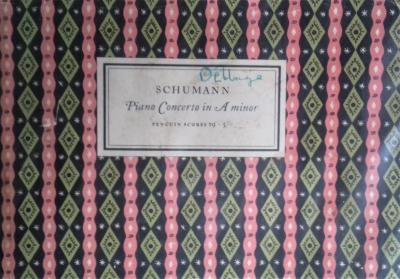
The mountain rises dark under the moon, and the stream rustles frostily through the heather- Book Bridge No. 4
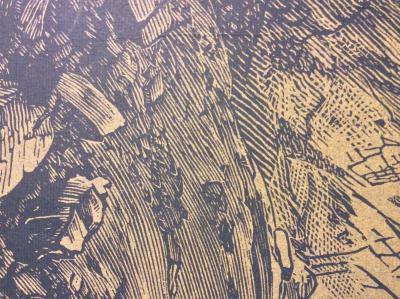
Cover image from a drawing by John Piper, wood-engraving by Reynolds Stone, words by R S Thomas
So excited to be showcasing The Mountains by R.S. Thomas as it is a fine example of how a symbiotic relationship between author and illustrator can bring a landscape to life on the page.
The landscape brought alive is Snowdonia, northwest Wales. The published work, by the Chilmark Press 1968, is ten lines of poetry plus fifteen pages of prose, by the Welsh poet-priest Ronald Stuart Thomas. The poem starts
“About mountains it is useless to argue;
You have either been up or you haven’t.”
Accompanying the text are ten images by John Piper, produced from wood engravings by Reynolds Stone.
A descriptive note by John Piper explains how conversations twenty years previously with Reynolds Stone had fueled a desire to publish a new type of guide to the mountains of Snowden. He laments the fact that despite the quantity of notes that he had made they did not amount to anything worthy of publishing. In contrast the freshness of his vision for the mountains was clear -
“I felt then that I was seeing the mountains for the first time, and seeing them as nobody had seen them before…Each rock lying in the grass had a positive personality.”
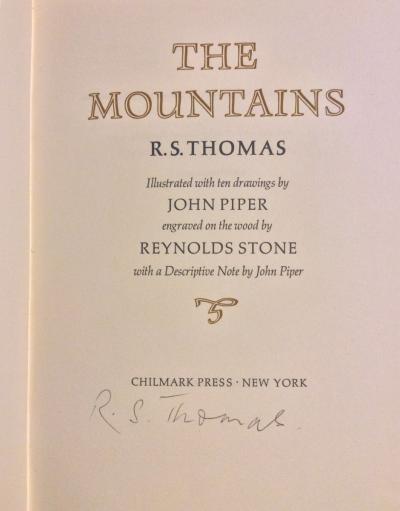
The connection between John Piper and Robinson College began in the 1970s when our benefactor, Sir David Robinson, wanted a modern stained glass window for the chapel and suggested Piper as designer, on the strength of his magnificent Baptistery window at Coventry Cathedral. Henry Woolston, our first bursar, remembers visiting his studio at Fawley Bottom, Buckinghamshire, and in 1985 Piper became an Honorary Fellow of the college. It was an association that continued after John’s death with Myfanwy Piper visiting on occasion and their grandson Luke studying Geography here.
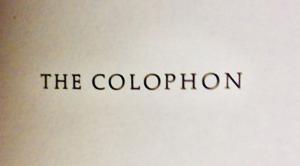
It is a beautiful oversize book, designed and printed by Will and Sebastian Carter at the Rampart Lions Press. The typeface is Palatino, designed by Hermann Zapf, and it is printed on mould-made paper from Wookey Hole Mill. This copy was donated to us by the Rt Rev’d Peter K Walker, Bishop of Ely 1977-89.
List of the ten engravings - drawn by John Piper, translated to wood engravings by Reynolds Stone
- Rhayadr Ogwen (or Benglog Falls)
- Yr Eifl (the Rivals) from a point on the Llanberis track to Snowden
- Fyynnon Llugwy
- The cone of Tryfan and the slope of Glyder Fâch from Llyn y Cwn, above the Devil’s Kitchen
- Rocks on Glyder Fach
- The butt-end of Y Garn, from the head of Nant Ffrancon; the Glyders behind
- Llyn Ogwen, Llyn Idwal and Litn Bochlwyd
- Maen Brâs (the Big Stone)
- Ffynnon Caseg
- Cwm Graianog
The Wrong Music: the poems of Olive Fraser 1909-77, introduced and edited by Helena M. Shire, Canongate, 1989 - Book Bridge No. 5
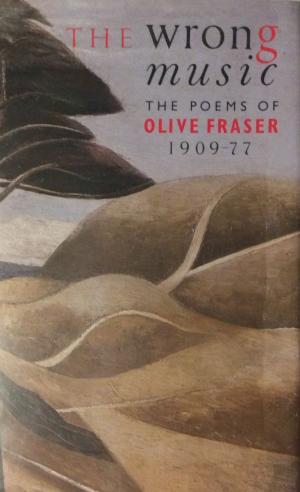
Book jacket painting Wood on the Downs by Paul Nash
Helena Shire (1912-1991), Founding Fellow at Robinson, edited two collections of poems by Olive Fraser who was a poet and university friend. It was troubling to Helena that so very little of Olive’s poetry was published during her lifetime and in the introduction to The Wrong Music Helena sets about answering “How did it come about that a hoard of outstanding poetry remained unknown?”
As she tells the story of Olive’s life we get an indication of Helena’s character, and the values that she held dear which would compel her to take on the project for wider exposure of a largely unknown poet.
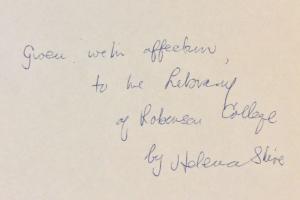
Handwritten note in our copy of The Wrong Music
Included in the collection are some stanzas from the twenty stanza long Fugue of Morning, which won the Calder Prize for English Verse whilst she was studying at Cambridge University. She actually won this prize for poetry twice, once in her first year and jointly in her fourth year.
A light there is, the fields of earth adorning.
The crying in the darkness is half told.
Rises up like a bird the great high morning
Sets on the grey hills top the marvellous gold
Saying with joy, ‘This world is never old.’
Helena assesses Olive's achievements thus:
“I claim for this poet, who belongs to the great old tradition of poetry, the classic poetic virtues: her poetry gives ‘instruction’ and ‘delight’. It gives instruction by widening our consciousness and understanding of the order of nature in all creation…But ‘delight’ is there too, in the old sense of sudden recognition of an identity unperceived before, in, for example, root and branches of a word. I know of no other poet in modern times who can so rouse the reverberations of meaning within a word, meaning perhaps dormant within its root-sense…” P.43-44
Recalling the friendship Helena says:
“We became firm friends and she called often at my home, only a short walk from King’s, where students were welcomed warmly by my mother at any hour and fed scones and tea.”
I have been reading through the library committee minutes from the establishment of our library and it was interesting to find that in 1981 Helena had produced the first exhibition in the library, with Olive Fraser as the subject of this exhibition.

We will honour Helena M. Shire, in the not too distant future and when it is safe to do so, with an exhibition in the library drawn from materials in our archives.
Olive Fraser entry Scottish Poetry Library
Mammoth tusks and the whole-set club – Book Bridge No. 6
In an age when Wikipedia is the go to reference tool I wanted to showcase the ninth edition of the Encyclopaedia Britannica, donated to us by our Benefactor Sir David Robinson. The gift came to us in 1981, six years before his death and around the same time he handed over two mammoth tusks, which are now kept in our archive. (See photo at the end by Joan Bullock-Anderson.)
In his article celebrating the 250th anniversary of the Encyclopaedia Theodor Pappas, writing in the Lapham’s Quarterly, tells of “the whole-set club”, an exclusive club of individuals who have read a complete print set! Theodor contemplates the meanings of the encyclopaedia when he describes it as:
“a reference work, a spark to learning, a symbol of aspiration, a recorder of evolving knowledge, and a mirror of our changing times..”
Our edition, published 1878-1889, is beautifully bound with marbled endpapers. It is complete in 24 volumes, plus an index, and is published by Adam and Charles Black of Edinburgh.
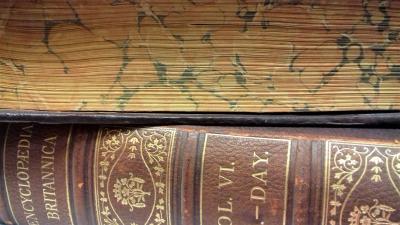
The ninth edition is known as the "the Scholar's Edition" and has contributions from the likes of Lord Rayleigh, Algernon Charles Swinburne, William Michael Rossetti and Robert Louis Stevenson. There are roughly 1100 contributors - the full list can be found at the end of the index - yet only a handful are women.
W. Robertson Smith writes in his preface to the index:
“But an Encyclopaedia, however brilliant its list of contributors, must always owe much to the constant and stated labours of a resident staff, whose members give their whole time to the work, and to these gentlemen a special acknowledgement is due. The Rev. George M’Arthur read every sheet of the book down to 1883, after which date he had the assistance of Mr J. T. Bealby…”
Notable for a significant article on the law relating to women and the first listing of evolution, this edition is much superior to the previous edition with its thick book boards, tactile leather bindings and abundance of engraved plates and maps. The history dates back to 1771, when the first edition was published and continues until 2010 with the fifteenth edition. The website is well worth a look.
This section for the website is an interesting example of how the organisation of knowledge evolved
“The 11th edition of the Encyclopædia Britannica contained almost twice as many articles as the last significant edition before it, but it contained only 15 or 16 percent more words. The difference had to do with editorial considerations regarding the matter of fragmentation. Although most of the major encyclopaedias of the past had devoted considerable space to any topic of major importance, there was increasing recognition in the 19th century that an alternative method of treatment would be to break large subjects into their constituent subtopics for alphabetical distribution throughout the set.”
Let us finish by returning to Wikipedia and their fascinating errors page.
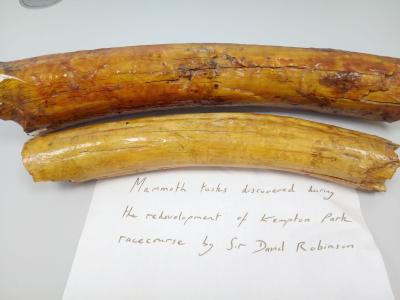
Sir David Robinson not only donated his set of Encyclopaedia Britannica to Robinson College he also donated two mammoth tusks.
“Hopefully they are still standing” Jacqueline Stieger on her bronzework at Robinson – Book Bridge No. 7
This week a slim exhibition pamphlet on the sculpture, jewellery and medals of Jacqueline Stieger, the artist who cast our bronze Chapel door panels and screen in 1980.
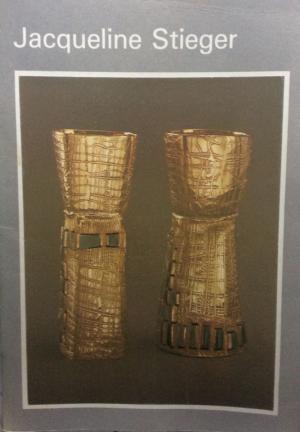
Born in 1936, Jacqueline studied painting at the Edinburgh College of Art before a move to Switzerland and a marriage to Alfred Gruber. In 1966 she and her husband moved to Yorkshire to set up a foundry in Humberside. There is a wonderful video showing her at work using the lost wax casting technique.
This pamphlet is from her first major solo show in Britain, 1985, and it adroitly distils the essential elements of her practise.
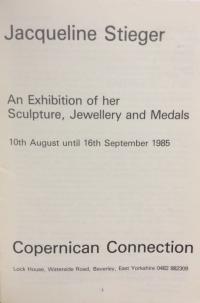
“Her sympathies have deep roots touching on and drawing fellow feeling from sculpture, jewellery and seals made many thousands of years ago in Sumeria, Egypt and Babylon. “
In an oral history interview, part of the British Library Crafts’ Lives Collection, she retells the making of the Robinson panels and screen – a commission which took her and two students a year to complete. It came about due to her friendship with the architects Gillespie, Kidd and Coia. Her desire to incorporate movement into the design for the doors was achieved by curves and relief work. As Jacqueline says “they almost looked like clouds.” The handles of the doors were produced by exaggerating the curve in order to make functional handles.
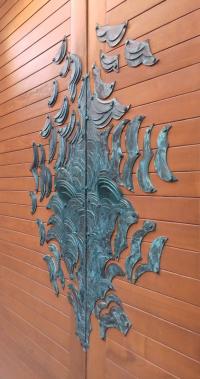


You can see more of her work here.
Beer-mats, bricks and a concrete frame - Book Bridge No. 8
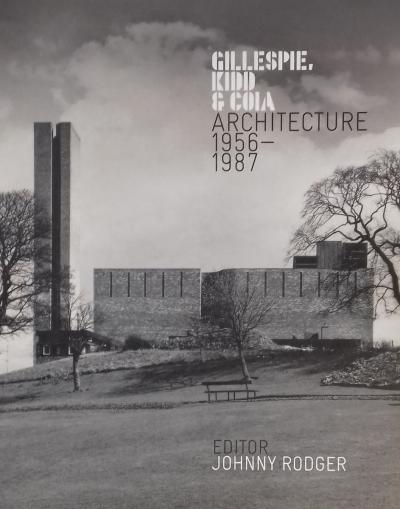
“The complex, challenging and prestigious Robinson College was GKC's last major undertaking.” Glasgow School of Art – Archives and Collections
This week a beautiful coffee table book - Gillespie, Kidd and Coia Architecture 1956-1987, edited by Johnny Rodger. It is published by The Lighthouse, Scotland’s Centre for Architecture, Design and the City in partnership with The Glasgow School of Art and the Royal Commission on the Ancient and Historical Monuments of Scotland. The book accompanied a major exhibition celebrating the work of the architects, which was held at The Lighthouse from 3rd November 2007 until 10th February 2008.
There is fantastic photography showing the newly built college, with the 1¼ million bricks, in 63 different sizes, enclosing a concrete frame. The photos look strangely stark without planting or people. Colin St John Wilson, in his appreciation of the architects, recalls how “it is said that the beer-mats in many a Cambridge pub were scrawled with the graffiti of architectural debate.” p.235
Both Isi Metzstein and Andy MacMillan inscribed our copy of the book in silver ink. It came to the library in 2011 from Christopher J Platt, then at the University of Strathclyde, later Head and Professor of Architecture at Glasgow School of Art. Chris writes in his letter accompanying the gift “they clearly remember the whole ‘adventure’ fondly.”
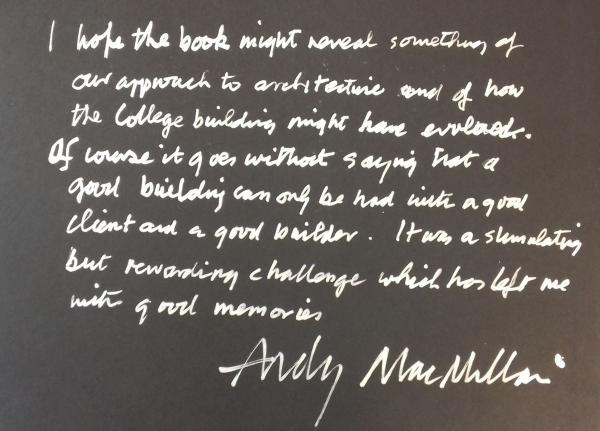
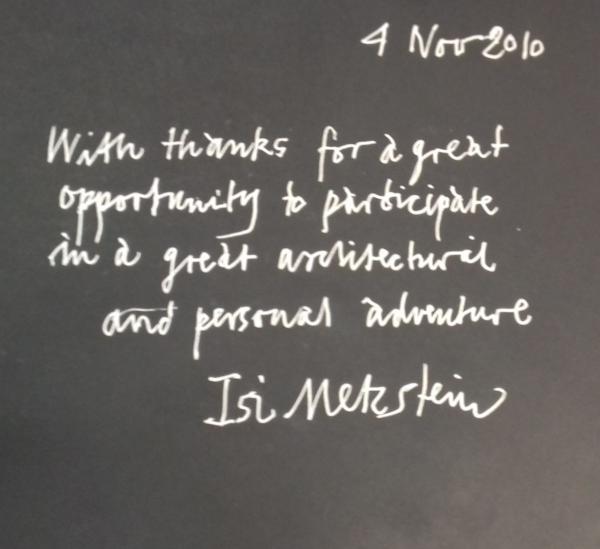
17 archive boxes of material relating to Robinson College are held at the Glasgow School of Art -Archives and Collections https://gsaarchives.net/collections/index.php/gkc-co-cam
The Bauhaus believer who strove to paint inner splendour - Book Bridge No. 9
The Imprisoned Splendour: the life and work of Sam Morse-Brown by David F. Raine, published 1993
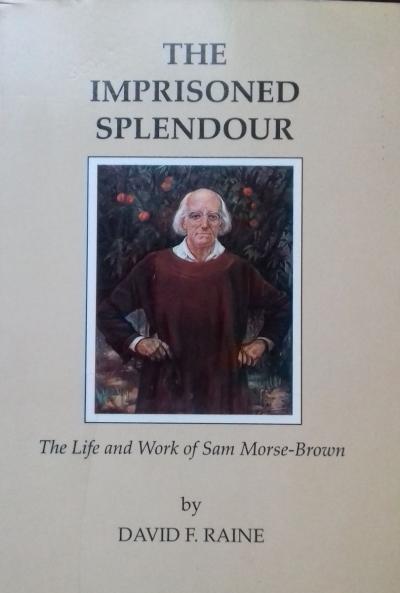
In the library, visible from the entrance floor, is a large portrait of Mabel Alice Robinson which was painted by Sam Morse-Brown (1903-2001) in 1959. Painted in oils it is an endearing portrayal of the wife of our benefactor, by an artist who earned his reputation for portraiture due to his ability to capture the spirit of the person in paint on canvas. He called these inner qualities “the imprisoned splendour” - a phrase which the author used for the title of the biography.
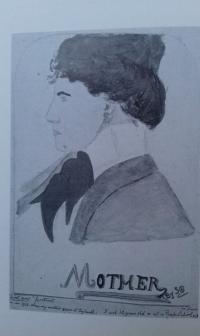
The research that David Raine conducted in order to write this short yet fascinating life story was thorough. Apparently there were hundreds of hours of interviews between the artist and the author and indeed a clear picture is painted of a gifted artist who continued to learn and remain curious throughout his life.
On his 90th birthday Sam Morse-Brown declared
“I don’t expect to reach my peak until I’m 95 – or perhaps even later, having outlived all of my critics and most of my good friends!”
Drawing of his mother by the 10 year old Sam
The commission in 1937 to paint 20 portraits of famous Welsh men and women for The National Museum of Wales cemented his reputation and solidified his philosophy that art should be enjoyed and available to all rather than just the privileged few. He was also an avid believer in Bauhaus principles.
Raine comments on the use of embellishments such as furniture, curtains, flowers, jewellery and wallpaper – “the artist was contriving deliberately to provide a subtle trail of clues into the less-tangible dimensions of personality.” The artist also used to take every opportunity to include his sitters’ dogs and horses.
I know very little about the woman in this portrait. Mabel Baccus married David Robinson when they were both 18 and she died in 1987, just three days after the death of her husband. The jewellery she wears in this portrait was stolen shortly after the painting was finished and never recovered. Whilst David was buried at sea Mabel is buried with her father just outside Cambridge at St Andrew’s Church, Impington.
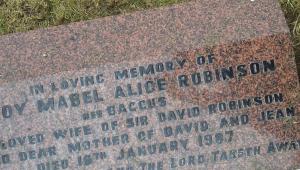
Theobroma cacao, an apothecary and conversation lozenges - Book Bridge No. 10
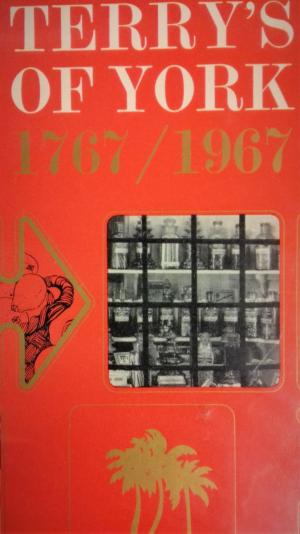
Terry’s of York 1767 -1967 is a privately published book on the history of the famous confectioner who is probably best known for the Terry’s Chocolate Orange. It seems that apple and lemon versions were also trialed but were not so successful and withdrawn from production. They had a diverse range which included All Gold, Devon Milk, Ginger and Velvet Assortment, Sparton, 1767 assortment, Waifa, Fruit Pastilles, Neapolitan, New World, Bitter Chocolate and C Mint lozenges.

It is a fascinating history with much to say about the rise in popularity of chocolate as a food, written in 1967 to celebrate their bicentenary year. The founder Joseph Terry was born in 1793 and as an apothecary his ability to ‘sugar a pill’ led easily onto the manufacture of confectionary. They started out as suppliers to the wealthy families of York, with products such as Joseph Terry’s Conversation Lozenges. These sound like a variation of Conversation Hearts, a type of sweet produced in 1847 when a Boston pharmacist invented a machine to manufacture apothecary lozenges. It was a time saving gadget to avoid grinding the raw ingredients by hand, with pestle and mortar. They posed such conversational gambits as ‘Can you polka?’
The book recognises the important difference between Terry’s and many other chocolate factories at the time:
“While they arrived at eating chocolate by way of cocoa, Terry’s came to it by way of confectionery. For them, it was a natural extension of their drinking chocolate manufacture: for Terry’s it was another kind of confectionery.” p.5

Fast forward some two hundred and fifty years, multiple generations of the Terry family and we find that after several changes of ownership the brand is now produced in France; the Terry’s Chocolate Orange is as popular as ever with 44 million sales each year. The book is part of our Button Collection of Business Histories, the story of how this Special Collection came to us at Robinson will be told another time.
A literary magazine and a poetry library – Book Bridge No. 11
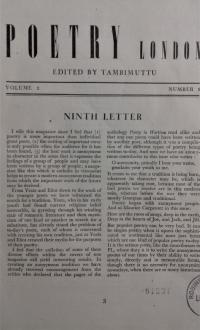
Book Bridge number 11 is a literary magazine from 1943? called Poetry London. This edition - volume 2, number 9 - is edited by Meary James Thurairajah Tambimuttu and is a fine example from the twentieth century poetry collection held at Robinson.
Contents include poems by Dylan Thomas and Louis MacNeice with prose pieces by Kathleen Raine and Herbert Read. The editor, recently arrived in London from Sri Lanka, was quick to establish his reputation with circulation of Poetry London rising to an impressive 10,000 edition sales by 1942. Beckett hails the magazine as “the most important poetry publication of the 1940s” in his article Tambimuttu and the Poetry London Papers at the British Library: Reputation and Evidence.
The magazine was founded in 1939 and continued to be published for twenty-three issues until 1951. The archives are now held at the British Library.
This edition contains three striking lithographs by Graham Sutherland drawn especially for Poetry London and printed at the Baynard Press. There are also small illustrations by Denton Welsh. Original artwork was a defining feature of each issue and there are also a number of anonymous odes and book reviews. A cryptic note concerning the anonymous contributor reads “The poems are neither George Barker’s nor the editor’s. We should like to see more of this poet’s work, under his own name.”
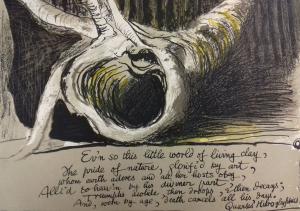
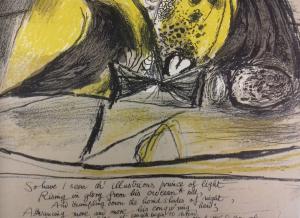
Lithographs by Graham Sutherland drawn specially for P.L. No.9 and printed at the Baynard Press
At the end of 1982 there was a discussion about housing The Poetry Society Library at Robinson College. A letter from their Chair, Alan Brownjohn, outlines that they were searching for new premises at a time when they and their 12,000 volumes had outgrown the space at Earls Court Square, London. It seems that the idea was rejected for a number of reasons, principally because as a newly established library the focus at Robinson was firmly on supporting undergraduate teaching.
If you want to see an example of this magazine the 1951 Festival Issue is available to view online
A piece of furniture and a mark of excellence - Book Bridge No. 12
What Wood Is That? A guide to the identification of home-grown and imported timbers with 40 actual timber samples by Dr Alfred Schwankl, translated and edited by H.L. Eldin. Published by Thames and Hudson, 1956
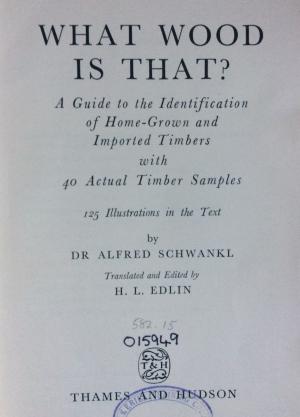
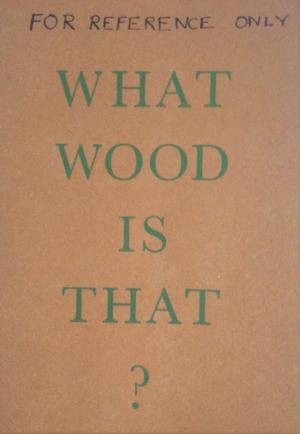
Repairs carried out on this small publication indicate that is has been very well used during the 65 years that it has been in existence. Originally published in German, the author describes it as a textbook for the professional and amateur alike.
“Everyone can recognize an oak, mainly because of the rugged bark of its stem and the irregular outline of its branches and of its foliage, which often forms little bunches amid the crown. These are all features that, taken together, build up the characteristic form of this tree. So has every other tree…”
The book has 125 illustrations, including clear and informative leaf designs and 40 small samples of wood which greatly aid identification. The samples are remarkably well preserved and to be able to see and touch these samples is indeed, in the authors’ words, a “novel device”.
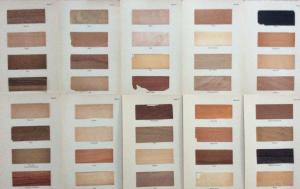
The story that this book tells is that of the 1250 cubic feet of virgin Douglas fir and 1000 square metres of Douglas fir veneered plywood used in the college library. In an article in The Architects’ Journal from 1981, the effect of such a beautiful interior of wood was described as being like “a large piece of timber furniture standing in a room”. Comparisons have also been made with the Mackintosh Library, Glasgow School of Art.
The Cambridge firm used was Johnson and Bailey, who employed 28 carpenters and joiners to complete the work. The craftsmanship involved resulted in the Carpenters’ Award in 1981 for “an outstanding example of joinery.” Sadly, the firm went out of business in 1994 after some 75 years of trading. This award, a mark of excellence, had its inaugural year in 1971 and went on to be rebranded in 2003 as the Wood Awards. The trophy is proudly displayed inside the library.
“The Wood Awards is the UK’s premier competition for excellence in architecture and product design in the world’s only naturally sustainable material. The Awards aim to recognise, encourage and promote outstanding design, craftsmanship and installation using wood.”
The Wood Awards website shows some stunning designs.
An architect writes about Cambridge stone – Book Bridge No. 13
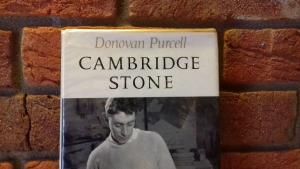
“To those who know the late Dr. W. J. Arkell's book on Oxford stone, the inspiration of the present work will be obvious...
Cambridge Stone is a book for all who love the buildings of Cambridge, and for architects and others who use stone.”
Donovan Purcell
Book jacket photograph "A banker mason, Michael Hobbs, in the workshop of a Cambridge masonry firm" by Edward Leigh, Cambridge
It might seem an unusual choice for a college built from bricks but my book selection this week is Cambridge Stone by Donovan Purcell, published by Faber and Faber in 1967.
I knew from Cutting Across Cambridge by Thomas Sherwood and Lida Lopes Cardozo Kindersley that the only stone available in Cambridgeshire was clunch, a type of hard chalk which is not the most durable of building materials. In this book the author gives us an informative chapter on clunch, believing that the most probable origin of the term is from the adjective meaning lumpy: heavy or stiff or close.
Without a source of good building stone projects in Cambridge needed to bring in supplies from further afield. We learn of the quarries in Lincolnshire, Northants and Rutland that supplied stone to Cambridge and how the cost of transportation could end up being one and a half times that of the stone itself!
Despite professing to some self-doubt when writing on the subject, the credentials of the author are solid as he was a practising architect who worked as Surveyor to the Fabric of Ely Cathedral, and a former lecturer at the Cambridge School of Architecture. He admits to some trepidation at his ignorance of geology but the research he carried out seems to have been extensive, including visits to quarry sites and stonemasons. The photographs, by various photographers, number over 50 black and white plates and are a delight.
The bricks of Robinson College may not have the beauty of stone but they do have a wonderful variety of hues. The colour of bricks depends on several factors including the local materials used, firing temperature and atmosphere in the kiln. Of the 1.4 million bricks used the colour composition was as follows:
Light Red 10%
Heather Red 15%
Multi Red 25%
Multi Brown 25%
Purbeck Brown 15%
Dorset Blue 10%
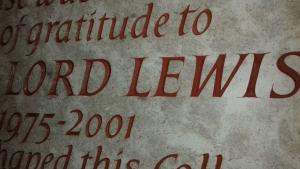
In our Chapel we have a beautiful memorial stone cut by the Cardozo Kindersley Workshop in Massangis French limestone. Dedicated to Professor Lord Lewis, the first Warden of Robinson College, the inscription cut in italic lettering and painted dark red reads -
This staircase was built as a symbol of gratitude to PROFESSOR LORD LEWIS Warden 1975-2001 whose wisdom shaped this College.
Snowdrops and other fabulous flora – Book Bridge No. 14
English Botany; or coloured figures of British Plants, with their Essential Characters, Synonyms and Places of Growth ed. John T Boswell Syme, 1858-1886, in 12 volumes plus a supplement.
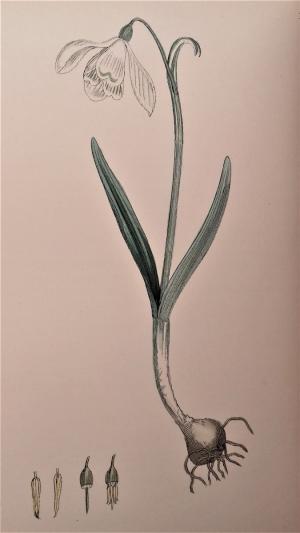
Galanthus nivalis, handcoloured lithograph
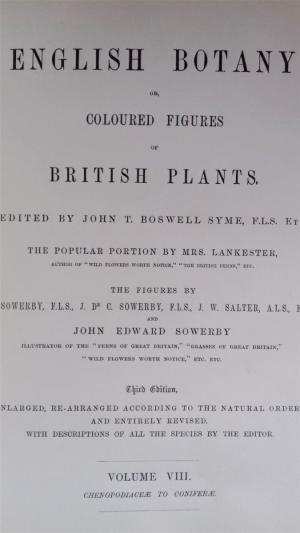
In a week when snowdrops have been peeping through the snow in our gardens I wanted to highlight what was known as Sowerby's English Botany, as it was illustrator James Sowerby who conceived the work.
Our library has the third edition of this ambitious publication, the first edition originally published as a 36-volume set between 1790 and 1813.
The illustrations are from delicate watercolours by botanical artist James Sowerby (1757-1822) who had been a painting student at the Royal Academy schools and an apprentice to English marine painter Richard Wright. He came to the attention of the publisher William Curtis who employed him to work on his publications and instructed him in botany. For the first edition the illustrations were reproduced from copper-plate engravings, by the time the third edition was printed in the 1850s the illustrations were hand-coloured lithographs. In an article from the journal Archives of Natural History we learn how the enormous cost of publishing these works caused financial ruin for London publisher Robert Hardwicke. Each volume, with a run of 1000 copies, cost £1000 and left insufficient funds to pay Sowerby adequately for his colour illustrations. Indeed the twelfth volume was published by a different publisher, George Bell and Sons.
The illustrations were used much later in the Observer's Book of Wild Flowers.
Mrs Lankester is credited with supplying the text for "the popular portion", producing nearly 400 entries. Phebe Lankester, 1825-1900, was an author of books and articles on botany and health. She used the pseudonym Penelope to write newspaper articles for twenty years, covering such topics as female employment and the importance of female representation on poor-law boards.
Sir James Edward Smith, who also supplied plant descriptions, refused to have his name on the work until the fourth edition. By this time the work had been well received and he was no longer concerned that the association would be detrimental to his standing as founder and first President of the Linnean Society.
This glorious set came to us in 1976, before our Library was established, and were donated by Paul Clifton Melville, Under-Librarian at the University Library from 1973-1976.
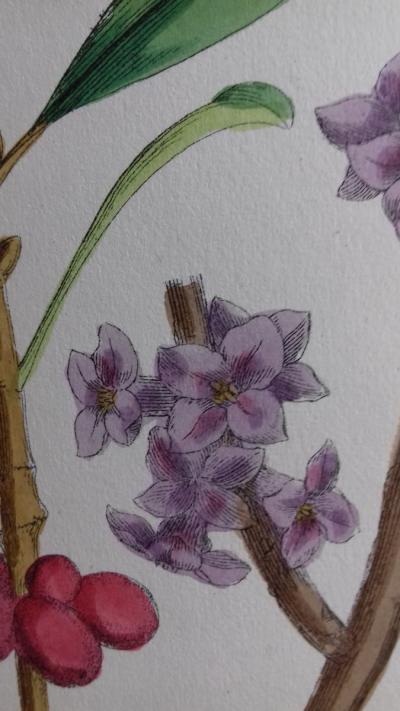
A Ship’s Bell - 77% copper and 23% tin - Book Bridge No. 15
In our Button Collection of Business Histories we have a small but delightful booklet from The Whitechapel Bell Foundry, London, called Church Bell Founding during Four Centuries. Ours is the second edition published in 1963.
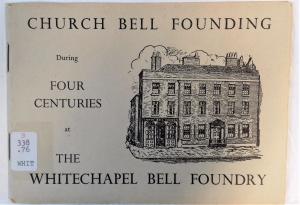
This foundry has been in the news in recent years due to a campaign to save it from closure – unfortunately the campaign was not successful. The business claimed to be “Britain’s oldest manufacturing company”, having opened in the 1570s and lasted right through to 2017. In the pages of the booklet the ancient craft of bell founding is revealed to us from the core and cope moulds to the final tuning process, originally done by hand chipping.
“The art of tuning is complicated by the fact that in every bell five partial tones are tuned together, and it requires patience and skill to bring each one accurately to its final pitch”.
Probably the most famous bell to come from the foundry is Big Ben, the great bell of Westminster, cast in 1858. In a companion booklet on English handbell casting there is an illustration showing the headgear worn in the 1860s. It is fascinating to find that paper hats were worn by the foundrymen!
“It was a custom here at the time for each man to be issued with a half sheet of brown paper every Monday morning for the purpose of making a new hat.”
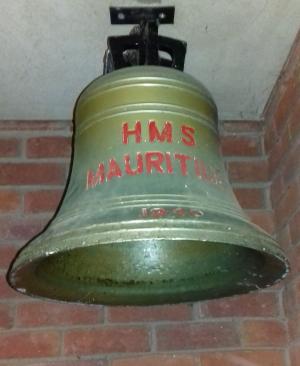
This booklet and the story of the Whitechapel Bell Foundry is particularly interesting to us as we have one of their ship bells at College. Hanging just outside our Chapel we have the bell from HMS Mauritius, on loan to us from the Ministry of Defence, which was cast at The Whitechapel Bell Foundry.
HMS Mauritius, a 6-inch cruiser of the “Fiji” type, was completed on the 1st January 1941 having been authorised in the Navy Estimates of 1937-38. In 1951 she ended her short but eventful life in the Reserve Fleet in Portsmouth, from where she sailed only to the breaker’s yard.
Digestive juices, pork pies and beer – Book Bridge No. 16
Die Verdauung Nach Versuchen von Friedrich Tiedemann und Leopold Gmelin, 2 volumes. Published 1826-7, Heidelberg und Leipzig
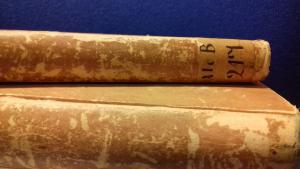
This important history of medicine publication was a collaboration between Tiedemann and Gmelin who were both employed at the University of Heidelberg, one as Professor of Anatomy, Physiology and Zoology and the other as First Chair of Chemistry. The work presented a series of investigations and new insights into the process of digestion.
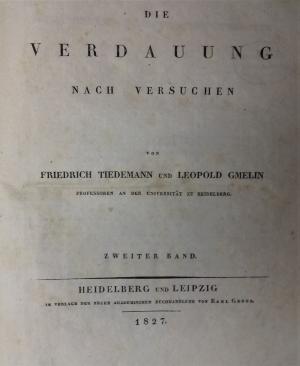
Jöns Jacob Berzelius, one of the founders of modern chemistry, stated that it was
“uncontestably the most complete physiological examination [of digestion], which has enriched the chemical study of the processes that occur in living animals.”
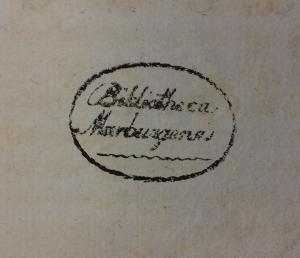
Previous mark of ownership
The authors published the two volumes three years after disappointment and resentment at not being the outright winners of a prize offered by the Paris Académies des Sciences for investigations into digestion. Instead they had to share the prize with two young French scientists, François Leuret and Jean-Louis Lassaigne.
Of course food is often associated with ceremonies and one of my favourite stories associated with the building of Robinson is of the topping out ceremony, as reported in the Cambridge Evening News, which ended with pork pies and beer.
“Work on the site stopped temporarily while dons and everyone on the construction site, from architects to apprenticed labourers, joined together for pork pies and beer.”
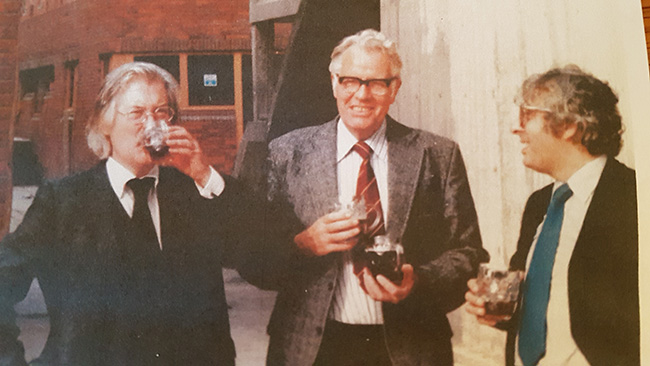
The photograph was taken in 1979 and shows Commander George Coupe (centre), marking the topping out ceremony of the Robinson buildings in the traditional way, together with Andy MacMillan (left) and Isi Metzstein (right) of Gillespie, Kidd and Coia, the architects.
[Photographer unknown. Archive ref. RCPH 4/3]
Why do we long for beauty? Book Bridge No. 17
The Unknown Craftsman: a Japanese Insight into Beauty by Sõetsu Yanagi, adapted by Bernard Leach, foreword by Shõji Hamada, 1972, Kodansha International Ltd.
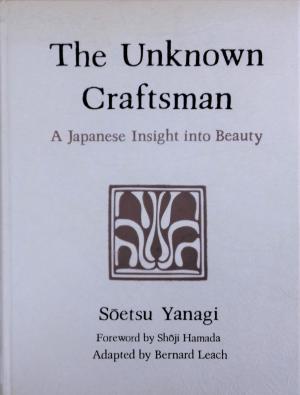
This week a truly beautiful book exploring in depth the subject of beauty. This first edition is bound with momigami, handmade mulberry bark paper and endpapers of tor-no-ko, a thick layered mulberry paper brushed with natural persimmon tannin and coated with alum and bone glue. The dye produced gives a colour which becomes richer and deeper with time.
The book opens with a tender sketch by Leach of Yanagi who sits lost in thought. The two potters enjoyed a friendship of some fifty years, connected by a similar sensibility for simplicity and beauty in craft. This book is a deeply reflective work with Leach selecting from Yanagi’s writings. Leach saw Yanagi as the Japanese equivalent to John Ruskin or William Morris.
“Why do we long for beauty? The Buddhists would reply that the world of beauty is our home and that we are born with a love for home.” p.155
The essay Seeing and Knowing, from 1940, contains three pieces of advice for the appreciation of art. Firstly we are entreated to look without judgement, secondly to look without intellect and finally to remove the ego from the seeing.
The discussion of craftsmanship stresses the necessity of use for the beauty of an object to be truly understood. There are also essays on Pattern, Irregularity and The Way of Tea, along with the distinction of folkcrafts from artist crafts. Finally there is the question “ought we to give up the machine?”
This concept of the unknown craftsman reminds me that I really must write about Patrick Reyntiens next time…


Patrick Reyntiens answers the beauty question - Book Bridge No. 18
Patrick Reyntiens: Catalogue of Stained Glass by Libby Horner, Sansom and Company Ltd, 2013
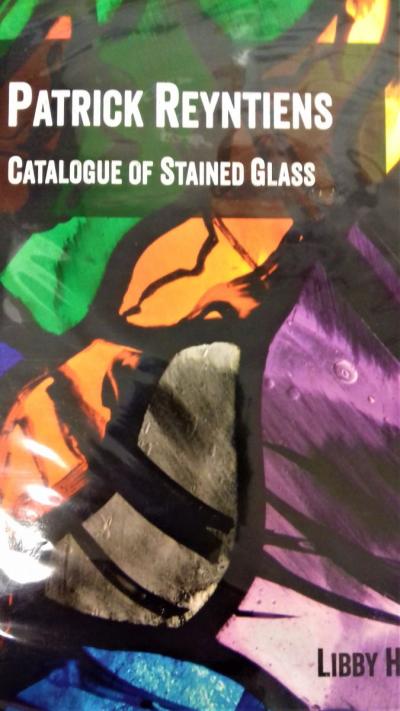
In Book Bridge Number Four I spoke about the connection between John Piper and Robinson College, so this week it is long overdue that I focus on the other half of the glass making partnership Patrick Reyntiens.
Dr Mary Stewart recalls how with Lord Lewis and the Senior Tutor she stopped off at the studio where Patrick worked, on their way to dinner at St Catherine’s in Oxford, the sister college of Robinson. They were delighted to see the progress being made on the small Chapel window. She remembers the layers of glass that he was using to give depth of colour and the acid baths which dissolved the glass, giving a variety of tones and a very pleasing texture. She also remembers with joy the small off-cuts of glass that he gave her to keep.
This lavish book, as the author Libby Horner herself admits, is a real labour of love. It is a weighty and comprehensive catalogue, organized by geographical region, of the 98 commissions and 600 autonomous panels that made up the long and productive career of this master glass designer and maker. At the beginning of the book there is a lovely photograph of Libby and Patrick, from 2011, sat at a table laden with food – there are bright green table mats and deep purple flowers. Just behind Patrick is a colourful stained glass panel, catching the sunlight through the window. The photo conveys the ease that built between the author and her subject over several years. Libby was obviously captivated by his work and keen to promote it.
“It was whilst making the film (about John Piper, commissioned by the Goldmark Gallery) and visiting Coventry, Liverpool, Aldeburgh, Sanderson and other venues that I began to fully appreciate just how important PR was in translating Piper’s often sketchy designs for stained glass, and that Piper’s windows would not have been as successful and important as they are without Reyntiens’ input.” Dr Libby Horner p.8
In our Archive (RCPP Walker 1/1) there is a letter written by Patrick to David (we are not sure who this is), dated 6th June 1996, where he recounts the painstaking process of making the Robinson windows. They took a period of two years to make and required meticulous colour-matching – “adjusting the dominant colour of one area into the sub-dominant of another, not necessarily adjacent, area.” It was slow –going and required much contemplation to get the “exact nuance of feeling and expression” that both he and John Piper envisaged.
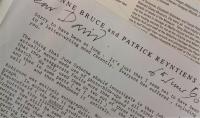
Finally a quote on beauty from an interview with Patrick in the Spectator, 14th December 2013, entitled God in a stained glass window
“I don’t know what beauty is really – except that in one way or another it is what we were all intended to experience. We don’t realise how incredible life is.”
From the Library of Daisy Greville - Book Bridge No. 19
The Weaker Sex: a comedy in three acts By Arthur W. Pinero, Published London: William Heinemann, 1894
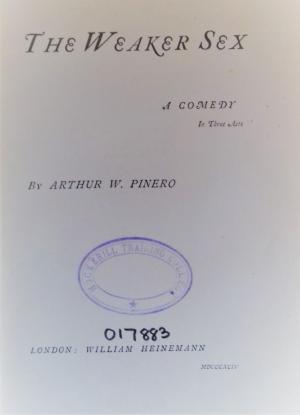
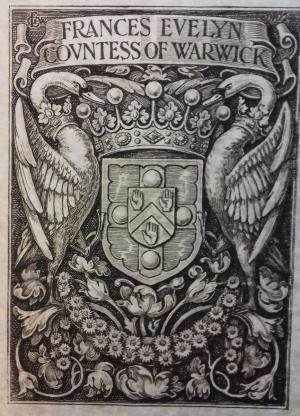
This week it is more about the bookplate than the book for this copy of The Weaker Sex, complete with the most beautiful end papers, once belonged to Frances Evelyn Greville, Countess of Warwick.
Born 1861 and known as Daisy she was a philanthropist, socialist and author who inherited her grandfather’s estate when she was just four years old. This estate was Easton Lodge in Great Dunmow, Essex where she commissioned Harold Ainsworth Peto to redesign the ten acres of garden in 1902. The redesign included a menagerie of birds and animals and with ongoing restoration the gardens hold monthly open days when the public can book to visit.
In the biography by Margaret Blunden we learn of the devastation caused by a fire at Easton Lodge in 1918. The fire broke out in the early hours of the morning on 22nd February and completely destroyed the West wing of the house, along with a lot of personal letters and papers.
“When the early morning light came, the fire was still going strong. Burnt fragments of vellum bound books, and the charred remains of valuable furniture and pictures lay among the smoking ruins of the West wing. " p. 260
One of the causes that Frances Evelyn was passionate about was education. She established colleges and schools for the education of women in agriculture, market gardening and needlework. This book came to us from Hockerill Training College, a place that had educated women teachers since 1852. Perhaps they acquired it after the death of Frances Evelyn, in 1938, when her possessions and artefacts were sold.
A miscellany of Cambridge history and customs – “rich things and rare devices.” Book Bridge No. 20
The Cambridge Portfolio, by the Rev. J J Smith, Published London: John W. Parker and Cambridge: J. and J.J. Deighton, 1840
This two-in-one volume history of Cambridge is choke full of information on all the tourist hotspots of the City. We learn about a portrait of Dr Caius, the Union Debating Society and the Legend of the Hills. The recounted struggles to establish a Botanic Garden, from the first unsuccessful plans for a Physic Garden in 1696, are particularly enlightening. Also fascinating are the pieces on the Woodwardian Museum, the Boat Race and Milton’s Mulberry-Tree.
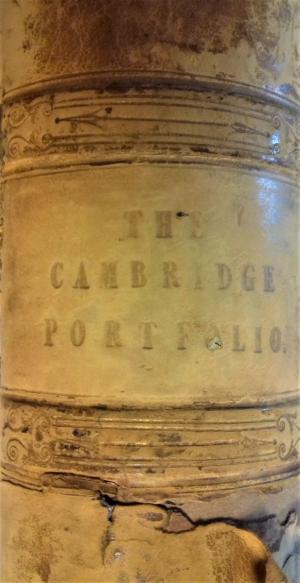
Do take a look at the online version, which can be consulted here.
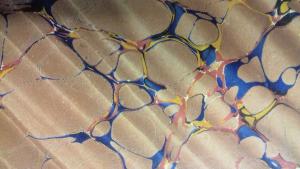
Image of the book spine, which is slightly the worse for wear, and the beautiful marbled endpages.
The author of the work, the Rev. John James Smith, was a Fellow and Tutor at Gonville and Caius. The illustrators commissioned for the publication included Joseph Murray Ince, 1806-1859, christened Josef-Marie Ince and Charles George Lewis,1808-1880. The title page contains a rather startling illustration, which is given some explanation on page 524.
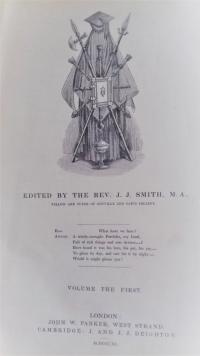
“Lest the reader be confounded at the apparently strange combination of symbols, exhibited on the title-page, which at first sight might seem to have been borrowed from some armoury, it may be here explained that he sees in that group emblems of authority appertaining to the chief Offices of the University; - the STAVES borne by the Bedells walking in procession before the Vice-Chancellor: - the CUP, of silver gilt, adorned with light engraving, served at his entertainments…: - the OFFENSIVE WEAPON…the STATUTE BOOK… “
An armorial bookplate indicates that Charles Cardale Babington was a former owner of our well-worn copy. Cardale Babington, 1808-1895, succeeded John Stevens Henslow as Chair of Botany at Cambridge in 1861. He was a true bibliophile and his generosity greatly helped the Plant Sciences Library. The Department has a magnificent oil portrait of him painted seven years before his death.
“The department's library also benefited from his personal generosity, for he regularly needed to supplement with his own funds the slender official budget.” Oxford Dictionary of National Biography.
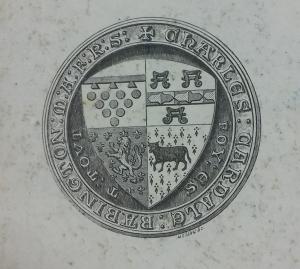
This volume came to us as part of the Bowles bequest from Valerie June Bowles, 1935-2019. Valerie was the daughter of Stanley C. Bowles, Mayor of Cambridge at the time of the founding of Robinson College.
Robinson College Archive Ref RCTR 5/1/11/2 includes: Feb-March 1974, note of a meeting in the Mayor’s parlour on 18 Feb 1974 relating to Council concerns over the choice of site, and exchange of letters between the Mayor (Stanley Bowles) and Jack Linnett [Chair of the Trustees].
A note on Valerie Bowles from former College Librarian Lesley Read.
Valerie June Bowles was born on June 16th, 1935 in Cambridge, the only child of Stanley and Ivy. Stanley worked for the Cambridge Water Company, eventually rising to manager, which gave him an unparalleled knowledge of Cambridge which he passed onto his daughter.
Valerie most probably started school the week war was declared September 1939. Living in Chesterton she attended the Shirley School, before moving to the Central aged 11. An abiding memory of the war was going with her best friend to see the German plane which had crashed on the allotments behind Warren Road. Valerie learnt secretarial skills, at which she excelled, and which led to her first post in the Civil Service, in the Department of Agriculture and Fisheries in Brooklands Avenue. She then responded to an internal advertisement for a post in the Foreign Office, to which she was successful.
A most interesting life followed as she was posted to Washington USA, where she spent the next ten years. A spell in London followed before her next posting abroad, this time to Oslo for five years.
Valerie resigned from the Civil Service to help her Father take up his duties as Mayor of Cambridge for the year 1973-74. A new career began in Cambridge, first as secretary to the Admissions Tutor at Churchill, and later as secretary to the Bursar at Pembroke, the post from which she retired. During those years Valerie had a flat in central Cambridge, which had a fabulous balcony adorned with plants. A few years after she retired she moved to Cottenham. She had always loved gardening and wanted a house with a garden, which she planned. Valerie’s interest in and love of Cambridge continued throughout her life.
She died on January 19th 2019.
A Modernist Cambridge House for a Medievalist and Economic Historian – Book Bridge Number 21
Medieval People by Eileen Power, Methuen and Co. Ltd, 1924
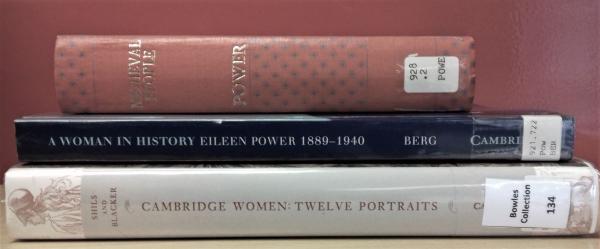
This book, published nearly one hundred years ago, ran to ten editions and became a bestseller. A success no doubt due to its emphasis on “a new kind of history”[i] and reader-friendly style. This new history was wide ranging, inter-disciplinary and highlighted the daily lives of ordinary people. Eileen sets out her novel approach in the preface:
“I believe that social history lends itself particularly to what may be called a personal treatment, and that the past may be made to live again for the general reader more effectively by personifying it than by presenting it in the form of learned treatises on the development of the manor or on medieval trade, essential as these are to the specialist.”
The companion volume, Medieval Women, is based on material she used in her lectures. It was edited by her husband Michael Moissey Postan and published posthumously in 1974. Berg, her biographer, credits Lady Cynthia Postan, Michael’s second wife, with bringing Medieval Women to publication. Eileen’s belief in popularizing the study of medieval history continued with BBC Radio broadcasts for schoolchildren, which she produced with her sister.
Eileen was certainly an impressive woman and her contribution to economic history deserves to be more widely known. Berg reminds us that in her lifetime she was as well-known as R.H. Tawney, G.M. Trevelyan and Marc Bloch. She has since largely disappeared from the historical canon.
Eileen was born in 1889 and her early life was clearly shaped by the conviction of her father for fraud, when she was 3. She also suffered the loss of her mother from tuberculosis when she was 14. In 1931 she gained the Chair in Economic History at LSE - as a woman progression was harde and pay was less. She moved with her husband to the house in Sylvester Road, which was bought by Robinson College in 1974, after Michael became Chair of Economic History at the University of Cambridge. They had the house specially built, in 1937 shortly after their marriage and then divided their time between Mecklenburgh Square, London and 2 Sylvester Road, Cambridge. Berg describes how the Cambridge house quickly became the gathering place for students, economic historians and a large circle of friends with Sunday afternoon ‘at homes’.
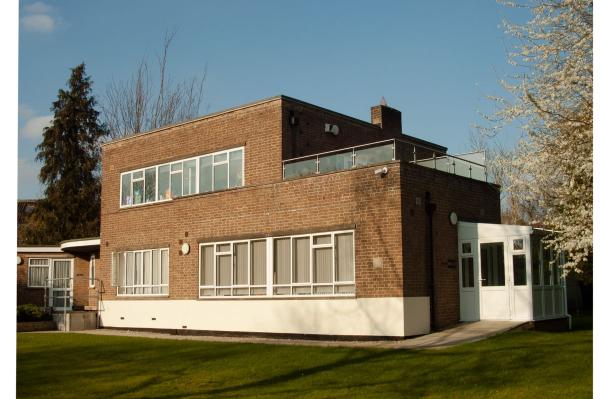
2 Sylvester Road, Cambridge. Image by Josué Brocca
At 51 she died suddenly of a sudden heart-attack, whilst in London. She was the eldest of three sisters and the two younger sisters, Beryl and Rhoda, destroyed her papers after her death. What is left of her personal papers are kept at Girton College, Cambridge https://archivesearch.lib.cam.ac.uk/repositories/19/archival_objects/370790
For a book published in December 2020 Francesca Wade conducted extensive research on Eileen Power, there is an excellent talk by Francesca here. Sue Donnelly, Archivist at the LSE reviewed the book, Square Haunting: Five Women, Freedom and London Between the Wars by Francesca Wade, her review can be read here.
[i] A Woman in History: Eileen Power 1889-1940 by Maxine Berg Published CUP, 1996.
What’s in a name? Joseph Needham and inspiring connotations – Book Bridge No. 22
Changing Perspectives in the History of Science: essays in honour of Joseph Needham edited by Mikulas Teich and Robert Young, Heinemann, 1973
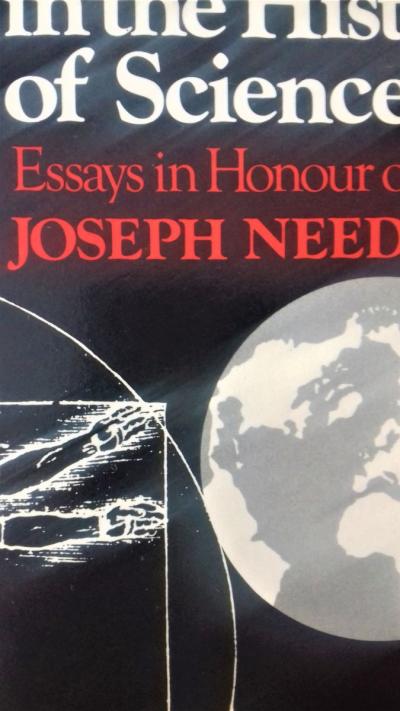
The scholarly field of the History of Science only really became established as a coherent discipline after the Second World War and with this volume we have a “state of the discipline” view from 1973. Honouring Joseph Needham, 1900-1995, it recognised the part he played in the evolving discipline, principally in the area of comparative history of science and technology.
The course of Joseph’s intellectual development is set out in a piece by Henry Holorenshaw “The Making of an Honorary Taoist”. The essay gives a biographical sketch of the man and how he came to instigate the comprehensive 7 volume, 27 book, Science and Civilisation in China.
“With the encyclopaedic contributions of Joseph Needham, on the development of science and technology in China, the myth that science and technology are essentially European has been exploded.” p. 52 A Rahman
Dr Noel Joseph Terence Montgomery Needham was one of the Trustees of Robinson College. At this time he was Master of Gonville and Caius and held the belief that there should be a special relationship between the two colleges. It was always his wish that his books should be housed in a library at Robinson and after several moves this came to fruition in 1991 when the Needham Research Institute, formerly the East Asian History of Science Trust, found a home in the grounds of Robinson. The architects of the new building were Lyster, Grillet and Harding.
When time came for discussions on the naming of the new College a letter dated 12th March 1974 from Joseph to Professor JW Linnett, Master of Sidney Sussex College and University Vice-Chancellor, shows that he was not keen on calling it Robinson College.
“Although I know that many people, including yourself, favour the family name or full name of the Benefactor, giving Robinson College or David Robinson College, I do not feel that I could vote for this. Most ordinary family names lack inspiring connotations. Nor could I see my way to voting for St. David’s as a compliment to the Benefactor, because the New Foundation will not have any special connection with Wales…”
Robinson College Archives RCTR 8/5/1
He then goes on to suggest Erasmus, Cromwell, Newton and Sherrington, before finally making a case for St. Gilbert of Sempringham.
Material relating to the preparation of Science and Civilisation in China can be found at the Needham Research Institute Archive.
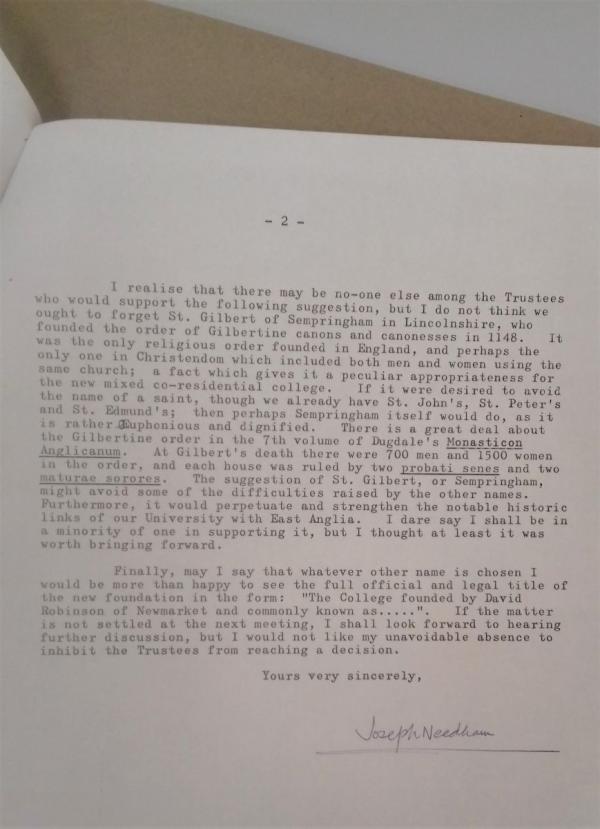
In Memory of Maria Björnson - Book Bridge No 23
Merce Cunningham Changes: Notes on Choreography edited by Frances Starr, 1968, published by Something Else Press
This publication is a fascinating selection from the working notebooks of Merce Cunningham, 1919-2009, which includes reflections on his art and the musical collaborations he produced with his partner John Cage. Mercier Philip "Merce" Cunningham was a ground breaking American dance artist and this volume is a permanent printed representation of his performances.
Talking about his art he said
“you have to love dance to stick with it. It gives you nothing back, no manuscripts to store away, no paintings to show on walls and maybe hang in museums, no poems to be printed and sold, nothing but that single fleeting moment when you feel alive.”
I particularly like the labyrinthine movement diagrams.
The publisher, Something Else Press, was established by Dick Higgins in 1963; it was an early supporter of concrete poetry and works of Fluxus artists. For some years the Press produced newsletters to promote the work it was doing, these can be seen here
At Robinson College we have an outdoor performance area, the Maria Björnson Theatre, which hosts, among other things, the annual Cambridge Shakespeare Festival performances. It was constructed in 2004 in memory of Maria Björnson, 1949-2002, who was a theatre, ballet and opera designer . We have this wonderful space thanks to Charles Hart, one of our early alumni, who knew and worked with Maria.
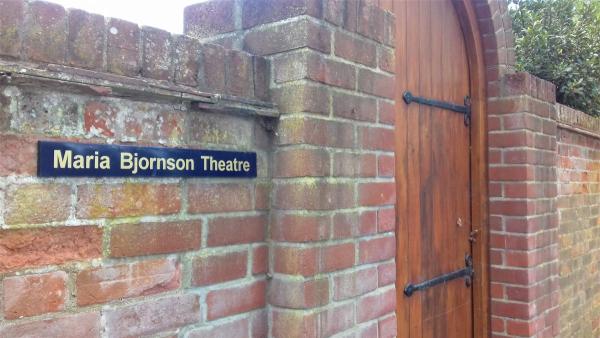
In this obituary by Robert and Olivia Temple, we get a glimpse of a truly creative life.
“From early childhood, she drew ceaselessly page after page of brightly costumed people, each with his or her own story. She and Olivia would discuss them as if they knew them all personally. Each face was different, each expression was of a specific emotion, and the drawings were sometimes overpowering in their vitality.”
Her archive is kept at Conway Hall in London.
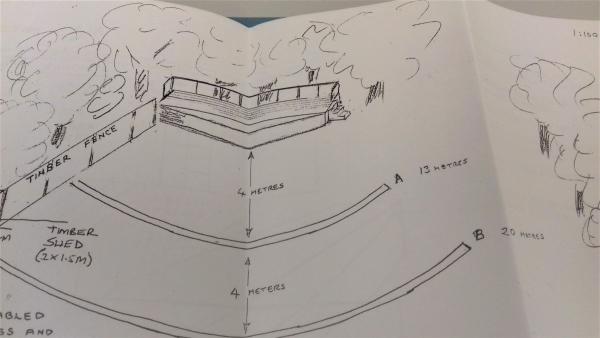
Plans for the Maria Björnson Outdoor Theatre in the Robinson College Archives ref: RCAR 2/2/7
A speech, a name change and a local cemetery – Book Bridge No.24
English Classical Scholarship: historical reflections on Bentley, Porson and Housman by C.O. Brink, Published by James Clarke and Co., 1985
Born at Berlin on 13th March 1907 Karl Oskar Levy’s ambition whilst at school was to become an orchestral conductor but what he actually went on to study was philosophy and classical philology. Two years prior to gaining his doctorate he changed his surname from Levy to Brink, then in 1938 came to Britain to join the editorial staff at the Oxford Latin Dictionary. The war brought a halt to publication so Karl took up work as tutor in Classics at Magdalen College School. This led on to academic posts at the University of St. Andrews, Scotland and Liverpool University before he came to Cambridge in 1954, as the Kennedy Professor of Latin. He had anglicized his forenames in 1948, the year after he gained British citizenship.
English Classical Scholarship was his last major work. In an article[i] in Gnomon: Critical Journal of the Entire Field of Scholarship on Classical Antiquity H.D. Jocelyn describes the rationale behind the book -
B. singled out the Englishmen he thought had made the greatest contributions, setting each in his historical context and making what he called ‘Bentleianism’ the intellectual thread which tied them together.
Discussions about a new college in Cambridge, what was to become Robinson College, date back to the late nineteen sixties. At this time Team 10 architects and New Brutalism were the flavour of the day. As Professor Charles Brink was a major influence right from the start and I can’t help but wonder how the scholar of Classics and the proposed modernist architecture found common ground.
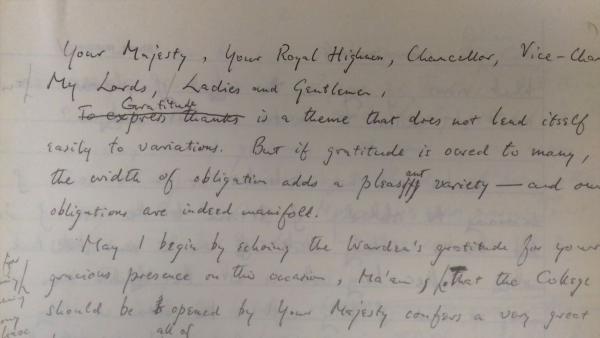
Image: Robinson College Archive RCPP Brink 2 - Brink’s handwritten speech for the official opening of Robinson College, by HM the Queen and Prince Philip, on 29th May 1981.
It was 1975 he became Chair of Trustees of Robinson College, after the sudden death of Jack Linnett. At this time he was a Fellow of Gonville and Caius College and apparently it was David Robinson who specifically asked for Charles to be one of the Trustees. It is certain that his ability to communicate well with David was vitally important to the success of the building. His work involved with the founding led to an Honorary Fellowship at Robinson in 1985, the same year that he donated this recently published book to the Library.
He died 2 March 1994 and his ashes are interred (Plot 2H13, with his wife Daphne Hope Harvey Brink) nearby at what has been nicknamed Britain’s brainiest cemetery, the Parish of the Ascension Burial Ground.
[i] Jocelyn, H. (1995). Charles Oscar Brink. Gnomon, 67(7), 650-655. Retrieved May 28, 2021, from http://www.jstor.org/stable/27692084
Business Offices and Business Books – Book Bridge No.25
Plough Court: the story of a notable pharmacy 1715-1927. Compiled by Ernest C. Cripps, Allen & Hanbury, 1927
This week I have picked one book from our Button Collection to tell the story of how business histories came to Robinson College. There is a quote on page 127 of Plough Court which says:
“ Business offices are all pretty much alike; at the first casual glance….But as one looks closer, peculiarities reveal themselves.”
This work on Allen & Hanburys of London was begun by Miss Amy Audrey Locke to coincide with the bicentenary of the Company, and then carried on by Mr. Arundell Esdaile of the British Museum after Miss Locke’s death. The final revisions and completions were carried out by Mr. E. C. Cripps and publication day finally came over a decade on from the first writings. It includes over forty sepia photographs.
It is a fascinating story of a company which grew from an 18th century apothecary shop. Allen and Hanburys Ltd were eventually acquired by Glaxo Laboratories Ltd., a GlaxoSmithKline legacy company. So who will it interest? The concluding pages of the book believe the readership to be the philanthropist, the medical man, the pharmacist and the commercial man.
It was also of interest to Mr Henry George Button. Henry was born in Manchester on 11th August 1913, he won a scholarship to read Modern Languages at Christ’s College, Cambridge and became a man with a thirst for knowledge and a love of facts. His working life was spent as a civil servant and in 1962 he won the Radio 4 Brain of Britain quiz. At the age of 64 he was finally awarded his MLitt degree, which he had begun work on 42 years earlier. His subject was the troubadours of Provence and Germany. In retirement, after moving to Cambridge, he became an honorary archivist at Christ’s College and a Cambridge City tour guide. He died at the age of 94 in March 2008.
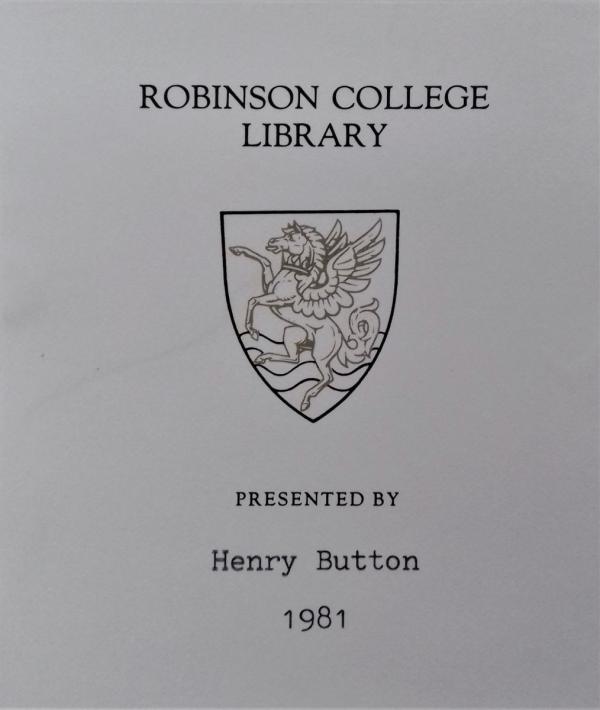
The first mention of a collection of materials on Business History can be found in the Library Committee minutes from November 1979. It seems that the offer came in a letter from Dr Whaley and was investigated by the Gifts and Bequests Committee. His book collection of business histories came to us in 1981 and work has recently begun to catalogue the titles into Cambridge University Libraries catalogue. Dr Mary Stewart, Life Fellow, recalls:
I'm pretty sure the first link was contact with our then historian Dr. Joachim Whaley, a young Fellow of Robinson for a few years - he knew Henry through Christ's, whence Jo had come to us and Henry was, I think, some sort of Senior Member. ( I also got to know Henry a bit later because I'd been at Oxford with his daughter Susan, now Baroness Garden.)
In an article about the collection he wrote for the Business Archives newsletter, 31st December 1969, he said:
“We need to gather what information we can about such old businesses before they are swallowed in mergers or oblivion.”
On Teachers and Teaching: our foundation collection – Book Bridge No. 26
History of Hockerill Training College by Grace Ashley Wood, 1938, Villafield Press
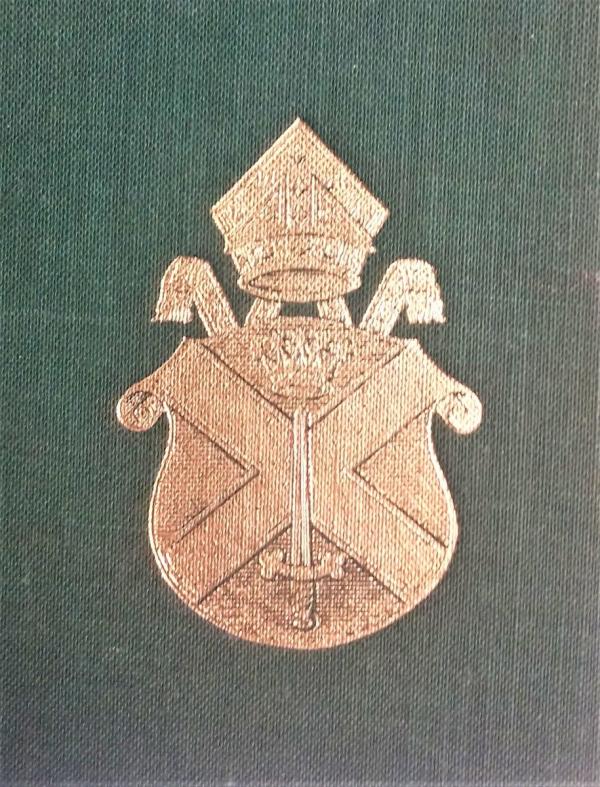
The Hockerill crest with the motto Onwards and Upwards
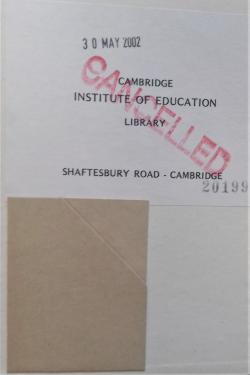
In this small book, with the gold embossed crest of the College on the cover, there are two previous marks of ownership. The first is handwritten by someone at the College just after the war – the inscription reads S. Knight H.T.C. 1918-20. The second, and this is why there is the Browne Issue System pocket inside the front cover, is a label from Cambridge Institute of Education Library, Shaftesbury Road.
Part 1 gives a potted history of the growth of education for teachers through the founding of teacher training colleges. These colleges followed on from the Monitorial System, a system which had used the most able pupils to help teachers in the classroom.
A Browne library pocket - a pre-technology paper based system for loaning books, invented by Nina Browne, a librarian at Harvard in 1885.
By 1860 there were thirty-four training colleges catering for over ten thousand student teachers.
“Hockerill was probably the tenth in order of foundation of the women’s colleges, whose history goes back to the founding in 1811, of the “National Society for Promoting the Education of Poor in the Principles of the Established Church throughout England and Wales.”
The establishing Committee, with Lord Bishop of Rochester as Chair, required four prerequisites of the proposed site:
- One or two acres of land
- Proximity to a railway station
- Possibility of obtaining sittings in the Parish Church for the students and staff
- Joining a practising school with the new institute
On 10th November 1852 Hockerill Training College opened at a site known as Bramblefields in Hertford, with the first pupil being Adelaide Harrison.
The development of the college up until 1938 included the arrival of Nonconformist students in the early years of the twentieth century and the building of the new library wing at the north-east corner of the site in 1912. We learn that at Christmas, 1912, with the Library built but not yet furnished, the staff held their Christmas dance there and festooned the bare walls with paper roses. Then, in June 1913, the Marchioness of Salisbury opened the Library by unlocked the Library door using a Golden Key.
The architect, Mr Slater, designed a lofty room divided into six bays each capable of taking a fair-sized table, and each with ample space for books.” p.68
It was these books that eventually found their way to us in 1978 and because our Library was not yet built they were stored on the ninth floor of Cambridge University Library, with additional space also found on the seventh floor of the tower.
Commander Coupe had been made aware of nine colleges of education which were due to close in 1978 and it seems the one at Bishops Stortford was most interested in selling their library bookstock. Negotiations for the purchase of the books took place between the Principal and Bursar, Miss J. A. Hall and Mr D. J. Newman and George Coupe, Assistant Bursar at Robinson. Correspondence suggests that George Coupe tried to help some of the members of staff facing redundancy gain new positions in Cambridge. The obligatory three removal firms were approached for quotes, with Proctor Removals Ltd of Glisson Road being chosen. Mr Peter Harper, Senior Under Librarian of Cambridge University Library kindly loaned “coffins” to transport the books.
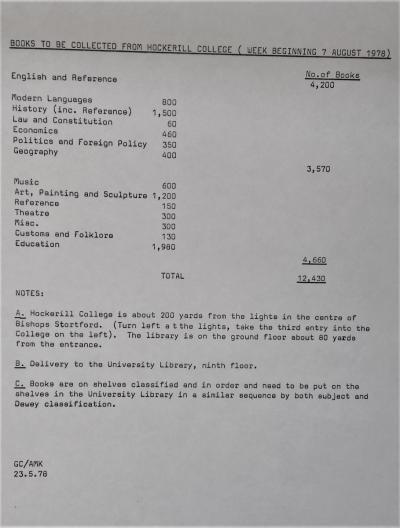
By 1980 our Library amounted to 23,000 books – 18,000 bought from Hockerill. Whilst the majority were stored and available for loan in the University tower some 2000 were in place in a room at Thorneycreek, “the Thorneycreek Library”, on oak shelving purchased from Lincoln Cathedral. It seems that an engineer was brought in to test the strength of the floor to ensure that it could withstand the weight of the shelves and books!
On Monday 30th March 50 boxes of books started to be moved from the University Library across Grange Road to the new Robinson Library. Apparently moving these books and the ones at Thorneycreek took four days, accomplished in time for the start of Easter Term 1981. In his letter P.A. Harper states
“Monopolising the tower lift should present no problems. I will warn the staff of the departments likely to be using this lift and if necessary get them to re-arrange their duties. I am glad that we have been able to be of assistance over the past months while your own library was being built.”
Colour-blindness, the way we see the world and accessible art - Book Bridge No. 27
Tests for Colour-blindness by Dr. Shinobu Ishihara, Kanehara Shuppan Co. Ltd, Japan, 38 plates edition 1976

Introduced in 1917 this test is the most well-known test for diagnosing congenital colour-blindness and consists of coloured dotted plates showing either a number or a path/line. A nine page pamphlet accompanies the test plates, giving a brief outline of the two types of red-green blindness, protanopia and deuteranopia.

The provenance of this publication is the Roussel Laboratories Ltd Medical Library, Wembley Park, Middlesex.


With one in twelve men and one in two hundred women being affected, I began to wonder how having the condition could change the appreciation of art. My guess is that relying on shape and form sculpture can offer more inclusivity than painting.
In 1985 there was an exhibition of sculpture in the grounds of Robinson College, entitled Have you seen sculpture from the body? This had shown at Tate the previous year before going on tour to three other locations. Photographs from the Cambridge Evening News show Isabel Langtry who represented the group of exhibiting sculptors, the sculptures and the Senior Bursar, John Grieve Smith. I am not sure how this exhibition came to College but in the Foreword to the exhibition catalogue Alan Bowness cites the desire to show the recent work of younger sculptors including Robin Greenwood, Anthony Smart, Hilde Köhly and Mark Skilton in an outdoor setting.
More can be read about Isabel Langtry on her website.
First Figure (“The Wrestler”) by Anthony Smart can be seen in the gardens of Robinson College and his recent work on his website.
Robinson College Archive: RCPH 7/11, RCRF 1/1/1/2 Various
Greek Vases and a College Crest, plus a chance conversation at a party - Book Bridge No. 28
Museum Oxoniense: Catalogue to the Greek Vases in the Ashmolean Museum, Clarendon Press, 1893 – copy number 20
When print runs are small I cannot help but wonder who the owners of the other copies of the book might be. The libraries of the University of Cambridge have three copies of this run of 350, a folio by Percy Gardner, who was the Lincoln and Merton Professor of Classical Archaeology and Art.

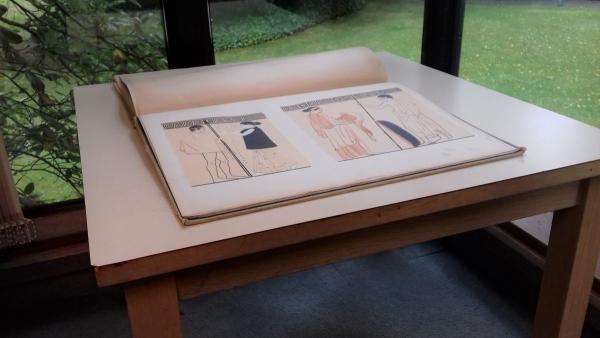
What is so incredible about this vase-catalogue is the superb quality of the photolithography drawings by artist F. Anderson. The Preface sets out the aim of highlighting what is interesting, whether the Museum can be visited or not. So rather than a comprehensive presentation it is the 27 plates of orange ochre, with contrasting black, which encourage a lingering look.
And so the jump to Pegasus and our College crest...
We have evidence in the College Archive that the suggestion for our crest came from a conversation at a party between Helena Shire, one of our Founding Fellows, and Lady Christian Mary Hesketh. In the letter from Helena Shire to Lady Hesketh, dated 1976, Helena writes
“Your suggestion for our crest of Pegasus is a winner. He has everything!”
Helena also enquires in the letter about an exhibition by Rory McEwan, Lady Hesketh’s brother, who was a botanical artist known for his leaf and flower watercolours.
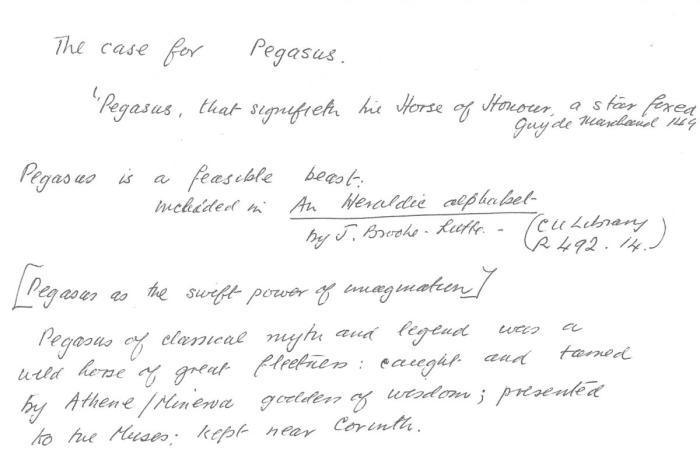
Robinson College Archive: Helena Shire’s notes on ‘The Case for Pegasus’ Archive ref: RCPP Shire 2/2
Goggle-boxes and a very skillful P.A. - Book Bridge No. 29
Historic Televisions and Video Recorders by Michael Bennett-Levy, MBL Publications, 1993
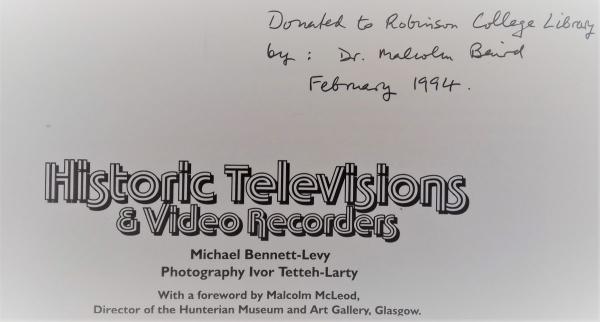
This is a fantastic slice of 20th century history and our copy, donated and signed by the son of John Logie Baird, is number 331 of a print run of 2000. The author, the grandson of one of the many men who worked on the production of the world’s first public television service, was a collector of television sets and video recorders and the book started out as a catalogue of his collection.
The book is dedicated to Dr Leonard Levy, M.A. (Cantab), D.Sc. (Lond), F.R.I.C 1885-1971, for his research into phosphors…
"almost certainly every single pre-war television illustrated in this book has its screen coated with phosphors made by his firm Levy and West."
Arranged in chronological order, the book includes a comprehensive appendix of every pre-war British television set. The author tells us that he was able to compile this list from pre-war advertisements, brochures and Radio Olympia exhibitors. The photography is by Ivor Tetteh-Larty.
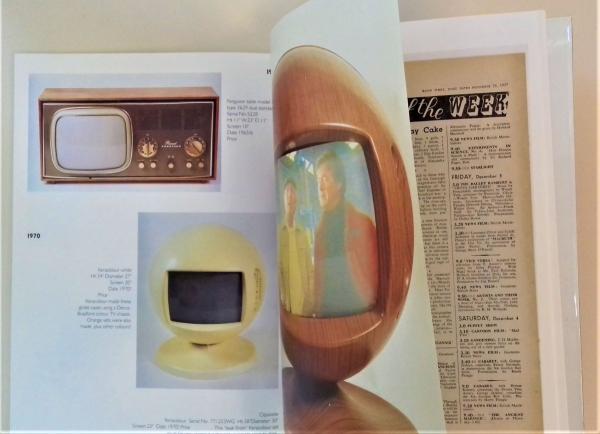
Flipping through the pages
It is fitting that we have this book, along with our Special Collection of Business Histories, because our philanthropic benefactor made much of his fortune from a television rental business. Whilst Sir David Robinson, the Newmarket millionaire, does not have much written about him there is even less known about the loyal woman, Peggy Umney, who served as his life-long P.A.
Peggy Daphne Beryl Umney was born in Bedford on the 26th March 1927. She was employed by David at the age of 15 and the memorial stone in our Chapel indicates how highly she was valued. It was Peggy who negotiated the difficulties which almost caused David to pull out of his most generous donation to found a new Cambridge college. The inscription in our Chapel reads “Without her help this college would not have been built.”
College honoured her with Honorary Membership and named the newly built Umney Theatre Suite after her in 1990. There is also a ward named after her, at David’s other big Cambridge benevolence, the Rosie Maternity Hospital. She gave the address at the funeral of Sir David Robinson which was held in Robinson College Chapel on Saturday 7th March 1987. She died on the 23rd December 1988, at the age of 61.
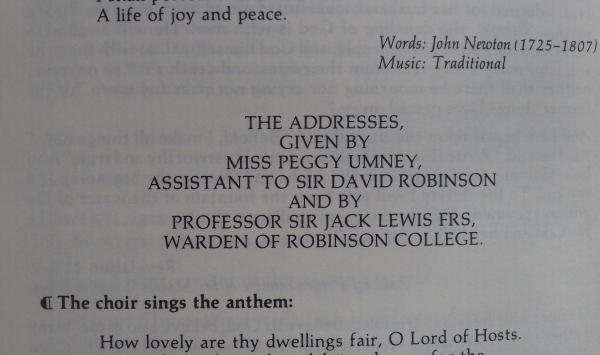
Remembering Nicola - Book Bridge No. 30
From the Heart edited by Julie Bomber, published by Poetry Today , 1997

This poetry anthology sits quietly on our shelves (827.081 BOM) in memory of Nicola Blakeman, a student who died shortly after matriculating at Robinson in 1994.
The notes beside the poem suggest that inspiration for her poem, A Soldier’s Lament, was most likely a recent visit to Ypres and the D-Day ceremonies.
The first line of the poem reads
"Remember me not with sorrow
- for such was not my way."
Nicola was a law student and her parents set up the Blakeman Fund which purchases books each year for the first year law students at Robinson.